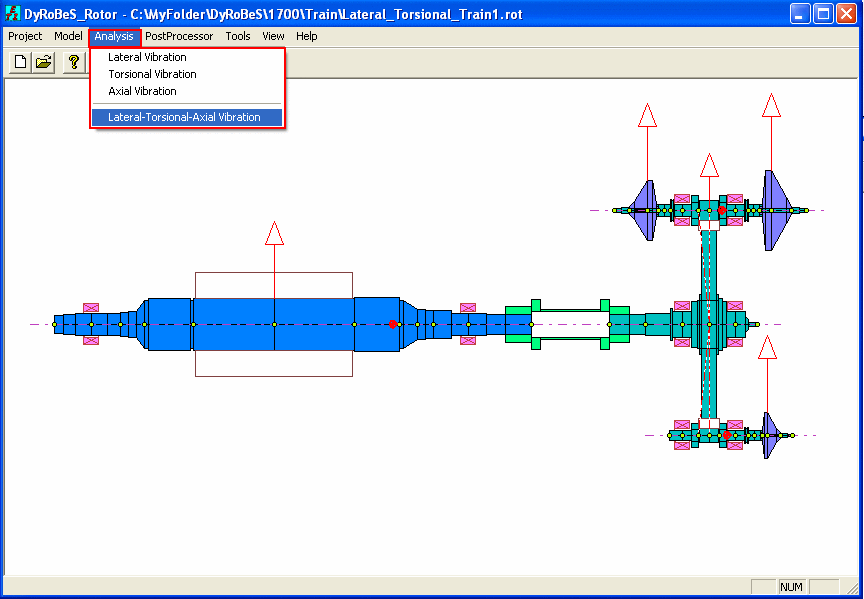Analysis
Once the rotor-bearing model (.rot file) is built, you now can proceed to the Analysis menu. DyRoBeS©_Rotor is capable of performing free and forced vibration analyses for Lateral Vibration, Torsional Vibration, and Axial Vibration.
The lateral vibration of the discretized system is described by two translational (x, y) and two rotational  coordinates at each finite element station. Note that Z-axis is the spinning axis. For torsional vibration, the motion of each finite element station is described by a rotational displacement
coordinates at each finite element station. Note that Z-axis is the spinning axis. For torsional vibration, the motion of each finite element station is described by a rotational displacement  about the spinning axis. For axial vibration, the motion of each finite element station is described by a translational displacement (z) along the spinning axis.
about the spinning axis. For axial vibration, the motion of each finite element station is described by a translational displacement (z) along the spinning axis.
The analyses for Lateral Vibration Analysis include:
Static Deflection and Bearing/Constraint Reactions
Critical Speed Analysis
Critical Speed Map Analysis
Whirl Speed and Stability Analysis
Steady State Synchronous Response Analysis – Linear System
Steady State Synchronous Response Analysis – NonLinear System
Time Transient Analysis (Time Domain)
Steady State Harmonic Excitation Response Analysis
Steady Maneuver Load Analysis
Time Transient Analysis (Frequency Domain)
Catenary (Gravity Sag) Analysis
The analyses for Torsional Vibration Analysis are:
Damped and Undamped Natural Frequencies and Modes Calculation
Steady State Forced Response Analysis
Transient Analysis (Time Dependent Excitations)
Startup Transient Analysis (Speed Dependent Excitations)
The analyses for Axial Vibration Analysis are:
Damped and Undamped Natural Frequencies and Modes Calculation
Steady State Forced Response Analysis
The analyses for the Coupled Lateral-Torsional-Axial Analysis are:
Whirl Speed and Stability Analysis
Steady State Synchronous Response Analysis
Time Transient Analysis (Time Domain)
Once the analysis is performed, you may go to the corresponding PostProcessor menu to view analysis results.
For more theoretical development, users are encouraged to read rotordynamics books. This help file is only used to guide the software use, not to cover the rotordynamics theory.
Analysis Options and Run Time Data
Under the Analysis menu, there are four options: Lateral Vibration, Torsional Vibration, Axial Vibration, and coupled lateral-torsional-axial vibration, as shown below:

You will need to select the analysis type and enter the run time data to meet your analysis requirement. You may input the run time data only for that selected analysis or you can input all the data for future use. Details on these four different analysis inputs (Run Time Data) are described below.
Lateral Vibration Analysis
Torsional Vibration Analysis
Axial Vibration Analysis
Coupled Lateral-Torsional-Axial Analysis
Dyrobes Home |
Dyrobes Help Contents
Copyright © 2014-2017
 coordinates at each finite element station. Note that Z-axis is the spinning axis. For torsional vibration, the motion of each finite element station is described by a rotational displacement
coordinates at each finite element station. Note that Z-axis is the spinning axis. For torsional vibration, the motion of each finite element station is described by a rotational displacement  about the spinning axis. For axial vibration, the motion of each finite element station is described by a translational displacement (z) along the spinning axis.
about the spinning axis. For axial vibration, the motion of each finite element station is described by a translational displacement (z) along the spinning axis. 